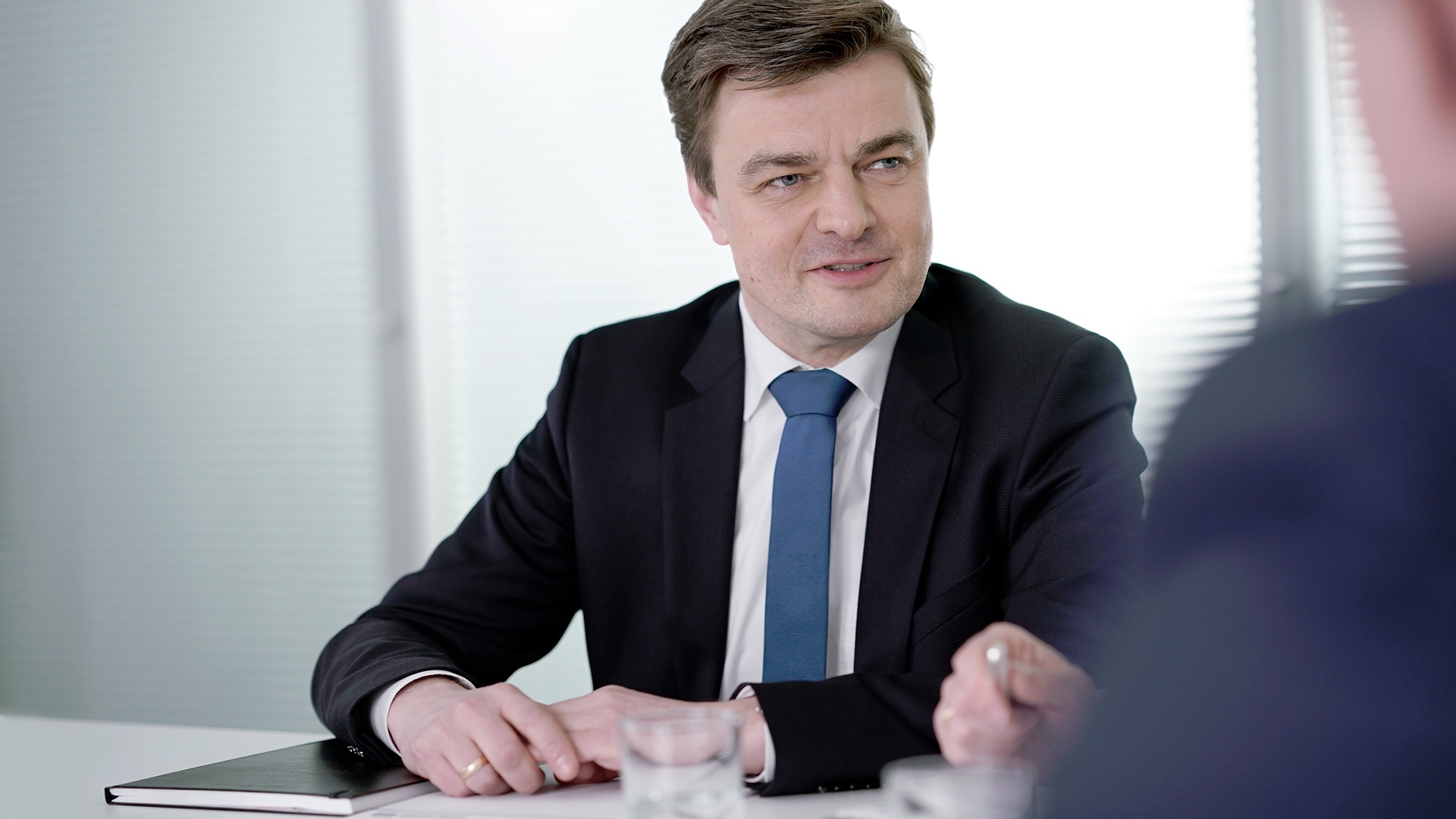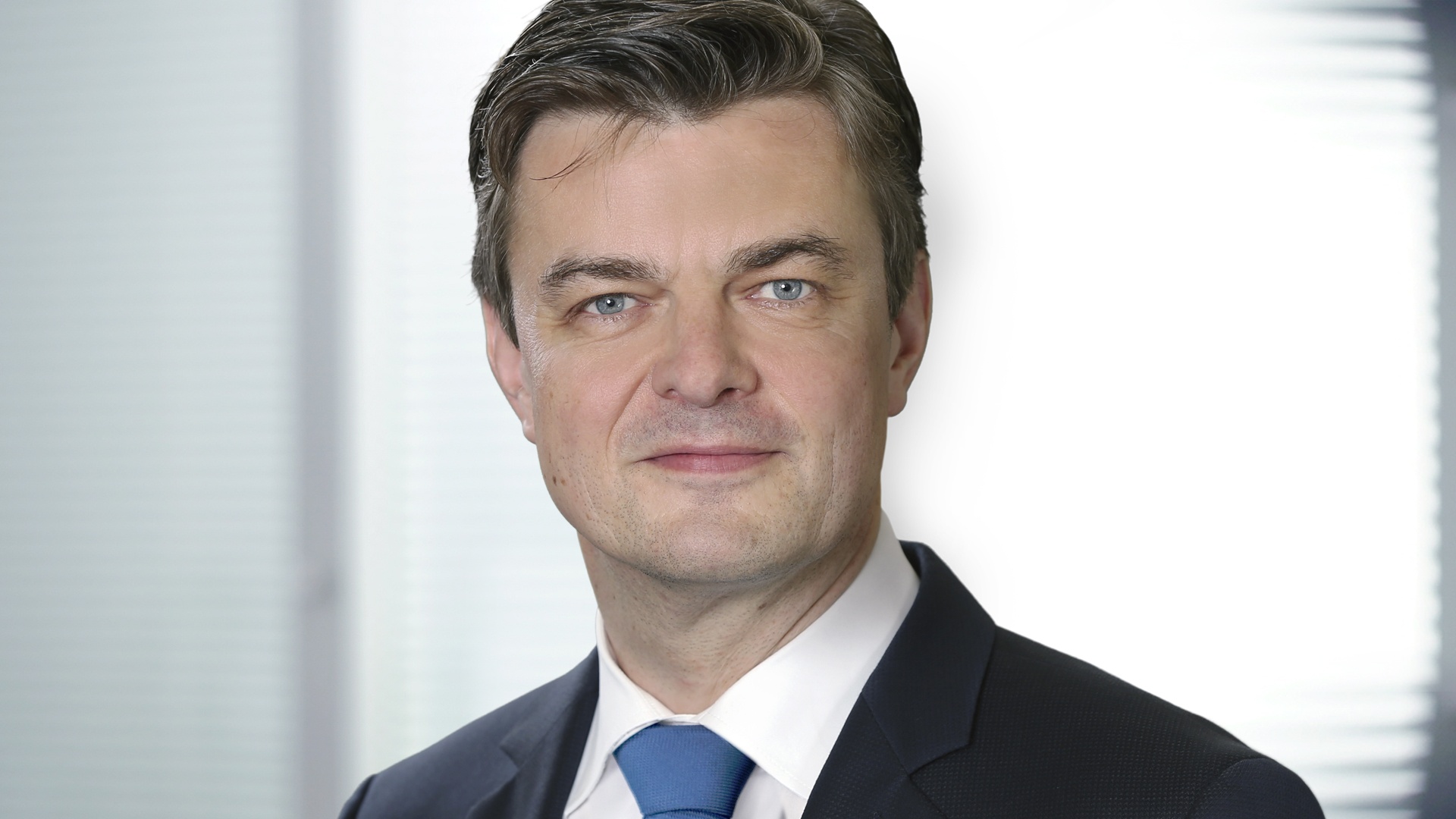
Interview with Dr. Jürgen Wilder: A company of real substance.
Dr. Jürgen Wilder is a Member of the Executive Board and responsible for the Rail Vehicle Systems Division of Knorr-Bremse AG. The division is gearing up for autonomous driving, enriching its after-sales services with data analysis, and plans to enter the clutch business in order to boost rail transport efficiency.
Info
The original interview was published in the magazine "EISENBAHNTECHNISCHE RUNDSCHAU" (ETR) No. 5/2019.

You have been Member of the Executive Board responsible for the Rail Vehicle Systems Division of Knorr-Bremse since September 2018. What areas do you focus on?
Knorr-Bremse is over 114 years old. Since the 1980s we have been on a path of strong growth, first with brakes and then with other systems for rail vehicles. With such rapid growth of the company and the number of products installed on the market, it is only logical that after-sales services also need to grow. We have taken this on board, also with a view to the future. Of course, Knorr-Bremse's growth has also resulted from leading the way in innovation in many areas – and we intend to keep it that way.
Can you describe your innovation strategy for Rail Vehicle Systems?
The market for rail vehicles is a growing market. In surveys, mobility is now valued more highly than fresh water, which is quite astonishing. As a group that offers systems for mobility, we therefore reflect the spirit of our time. On average, we invest 5.5% of our revenues in research and development, focusing on cost reduction, urbanization and climate protection. Building on this, we have defined seven innovation directions: connected systems, automated and autonomous driving, new product generations, frictionless brakes and airless trains, data-driven business, life-cycle cost reduction, and eco-friendliness.
What are you working on in the field of automated driving?
We are working on a research project on brake distance management. The aim is to assist the locomotive driver with precise braking in different weather conditions. This is an important task in terms of increasing the frequency of trains on the line, for example. Each braking action must reliably lead to the same stopping position. This kind of driver assistance does not yet constitute automated driving, but the technology being developed is one component of it.
So you use sensors and analyze data from inside and outside the vehicles to control the brakes?
Exactly. This is an iterative process where computing power ultimately serves to brake a high-speed train with pinpoint accuracy.
Are you laying the groundwork for automation with driver assistance systems?
Driver assistance systems can already be used for automated driving today. Our iCOM Assist system, for example, is used by Deutsche Bahn as an advisory system to reduce energy consumption. In Australia, Rio Tinto is running entirely driverless trains with this system. In addition, the use of driver assistance systems can improve the capacity utilization of the infrastructure. With new technologies such as those now available to us through our investment in RailVision, we have taken a major step towards automated driving.
You recently acquired a stake in RailVision. They specialize in obstacle detection for rail vehicles.
Obstacle detection is an important topic for the future. We don’t necessarily have to develop everything ourselves here at Knorr-Bremse. Sometimes smaller organizational units can be quicker to innovate than large companies. The trick is to recognize the potential of an innovation and exploit it for our benefit. RailVision has developed a technology that can see very far ahead, up to two kilometers, using a combination of image recognition and infrared technology. This is a prerequisite for autonomous driving.
A locomotive driver can’t usually see two kilometers ahead either.
That's true. But if you can see that far using RailVision, you can improve safety in rail operations. Another application, and one that can be implemented quickly, is to use modern image recognition techniques to precisely monitor the condition of the infrastructure and then carry out highly targeted maintenance in and around the track bed. This makes maintenance more effective and more efficient. We are expecting to derive this kind of added value from our investment in RailVision.
What other technologies will you be embracing in terms of autonomous driving?
We do not currently offer a complete system for autonomous driving. This requires close interaction with signal technology, which we do not have in our portfolio. But we believe that, especially in combination with the brakes, we can provide elements that together enable a business model for autonomous driving.
You mentioned frictionless brakes and compressed air-free trains before. Would you care to elaborate?
With electric motors, braking can also be achieved by reversing the drive. That may sound simple, but it isn't in reality. It only works in certain braking ranges and will certainly not replace the friction brake overnight. Nevertheless, we want to fully understand this development and, if appropriate, derive implications for our business.
What comes under the heading of connected systems?
In our portfolio we have a train control management system from Selectron that we use to equip our subsystems and their control units with communication capabilities. The subsystems are thus connected and can communicate with each other. However, this is not specific to our train control management system; it is vendor agnostic, as there are suppliers on the market that offer their own train control management system for their own subsystems.
Is there clarity as to who owns the data and how it should be handled?
There's no simple answer to that. We are not yet that far. Personally, I believe that the market is beginning to realize that in closed systems, where manufacturers do not share their data, the added value of this data is very small. Added value only arises when the data is combined – because by combining different diagnostics, knowledge can be taken to a new level. This can give rise to new business models for the individual players. Time will tell whether I am correct in this assessment.
Even if the players are in competition?
There's room for everyone in the market. Everyone can have a piece of the pie. Of course, everyone has their own idea about what piece they should get.
With an EBIT margin of 17% in the rail vehicles business, Knorr-Bremse has cut itself a nice slice of pie.
Business in the rail vehicle industry is very long-term. Over the past decades, we have grown by more than 10% per year. Our strength lies in our long-standing presence in the markets, including countries such as Japan, where there are hardly any European players. Customers have great confidence in us and recognize our expertise and reliability.
You mentioned an average growth rate of 10%. In 2018, growth in the Rail Vehicle Systems division was 6.2%.
When we look back, of course there have always been fluctuations. And we have to distinguish between organic growth and growth through acquisitions. We have set ourselves the goal of achieving substantial growth in the future.
You have received 26 metro orders in China. Given China's own production capacities, where is there room left for Knorr-Bremse?
There is certainly an intention in China to become more self-sufficient in supplying the market. Nevertheless, we remain attractive to the Chinese market thanks to our innovations. The figures for our Asian business show that this is a growing market for us – especially in the services business. We have earned our position in the Chinese market over the past decades, we have a large installed base there and can even compete as a supplier for products being exported from Asia to other countries.
You mentioned the after-sales business as an important area of development. It currently makes up just over 40% of sales. What variables do you particularly need to address here?
The services sector has developed enormously in recent years. Life-cycle costs play an increasingly important role in the awarding of contracts. The aim here is to optimize service intervals and service costs so that no jobs are being carried out unnecessarily. Of course, safety always comes first. But through modern data analysis and actual status descriptions, rather than just projections, we can already determine with great certainty when a component really needs to be replaced. We can offer models that increase reliability. This is attractive when, for example, high penalties have to be paid in the event of failures. What's more, greater reliability, by lowering the risk of failures, reduces the need to keep replacements in stock.
Take us through it: Knorr-Bremse subsystems record their own status, then Knorr-Bremse analyzes the data. At some point, this data must be passed on to the vehicle manufacturer and/or operator and incorporated into their maintenance system.
The point at which this happens is a matter for negotiation and must be contractually agreed. We have a range of different customers in the services business. Naturally, we have vehicle manufacturers as customers, but also large operators that perform most maintenance tasks themselves. When you talk to Deutsche Bahn today, one topic comes up again and again: the variety of parts that need to be managed.
The phenomenon that Uwe Fresenborg, CEO of DB Maintenance, calls the "vehicle zoo".
As a supplier of subsystems, we see it as our task to further standardize components so as to minimize this diversity in the long term and reduce costs. Of course, the vehicle manufacturer's business model also plays a part in achieving a certain degree of standardization. In the end, however, standardization can be implemented more effectively at the subcomponent level.
Is 3D printing already relevant to you?
We have already installed several 3D printers and are testing the technology. For small series that need to be delivered quickly, the technology makes sense. However, I don't see that it can replace large series production.
You talk a lot about effectiveness. Do you have some thoughts on how it can be increased in rail freight transport?
This is an old hobby of mine. Efficiency certainly can be increased in rail freight transport, and it must be. But I am not saying anything new when I stress that the political framework also needs to change in favor of rail freight transport. As Knorr-Bremse, we can contribute to this by increasing public acceptance of rail freight transport with quiet brake pads. Without quieter freight trains, rail freight transport will understandably come up against resistance. Certainly a product like the driver assistance system iCOM Assist offers one way to significantly cut costs. Automatic couplings are another major topic in terms of minimizing manual shunting steps. Knorr-Bremse also intends to enter the clutch business. We have earmarked research and development funds for this purpose.
So we could see an automatic central buffer coupler from Knorr-Bremse?
That would be one potential product.
Knorr-Bremse has been listed on the stock exchange since autumn 2018, as a member of the M-Dax index since mid-March. Has this changed anything for the Rail Vehicle Systems division?
The reason our IPO was so successful is because we are a company of real substance. Our winning formula is to offer innovative products and systems and to be equally efficient and reliable.
With a profit margin of 18%, the pressure to rationalize may not be so high.
We would never be able to maintain such a profit margin without constantly working on efficiency improvements and new products. We will certainly not rest on our laurels.
Nonetheless, will you tell us what you personally do to relax?
I work long hours with great focus during the week, so I try to keep the weekends as family time.

Dr. Jürgen Wilder
Jürgen Wilder joined the Executive Board of Knorr-Bremse AG in September 2018, with global responsibility for Rail Vehicle Systems. Holding a doctorate in physics, Wilder was CEO of DB Cargo from 2015 to 2018, where he was responsible for Deutsche Bahn's worldwide rail freight operations. After completing his doctorate, Wilder became a research associate at Harvard. He began his career in business at Siemens, where his positions included CEO Rolling Stock Business USA, Head of Strategy Infrastructure and Cities Sector and, before he joined DB Cargo, CEO Global Business Unit Mainline Transportation.